Osteoporosis: Risk Reduction Poster and Justification for Older Adults
VerifiedAdded on 2022/11/25
|9
|1688
|420
Report
AI Summary
This assignment is a report focusing on osteoporosis, a health risk affecting older adults, and it includes a poster and a written justification. The report begins with an introduction that highlights the importance of disseminating clinical knowledge through posters for effective patient education. The rationale section provides context on the prevalence of osteoporosis in Australia, its impact on the aging population, and the associated health risks, such as fractures and depression. The report targets women over 50, explaining their increased susceptibility due to factors like menopause and hormonal changes. The content rationale emphasizes clear, concise information suitable for patients, while the aesthetic rationale discusses the importance of visual appeal in capturing attention. The conclusion summarizes osteoporosis as a disease that weakens bones, increasing fracture risk, and emphasizes the importance of early detection and prevention through medical check-ups. References to relevant studies are provided to support the claims made in the report.
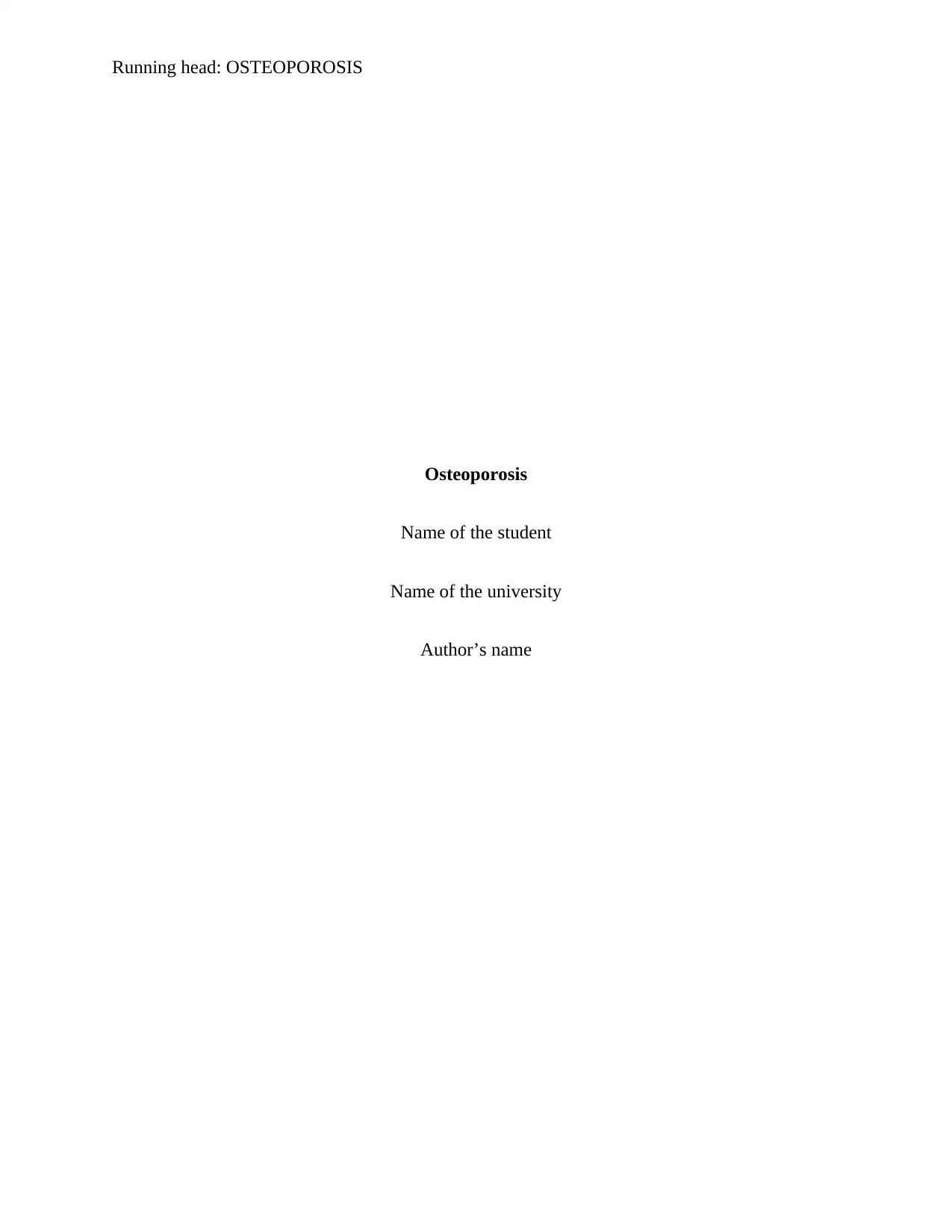
Running head: OSTEOPOROSIS
Osteoporosis
Name of the student
Name of the university
Author’s name
Osteoporosis
Name of the student
Name of the university
Author’s name
Paraphrase This Document
Need a fresh take? Get an instant paraphrase of this document with our AI Paraphraser
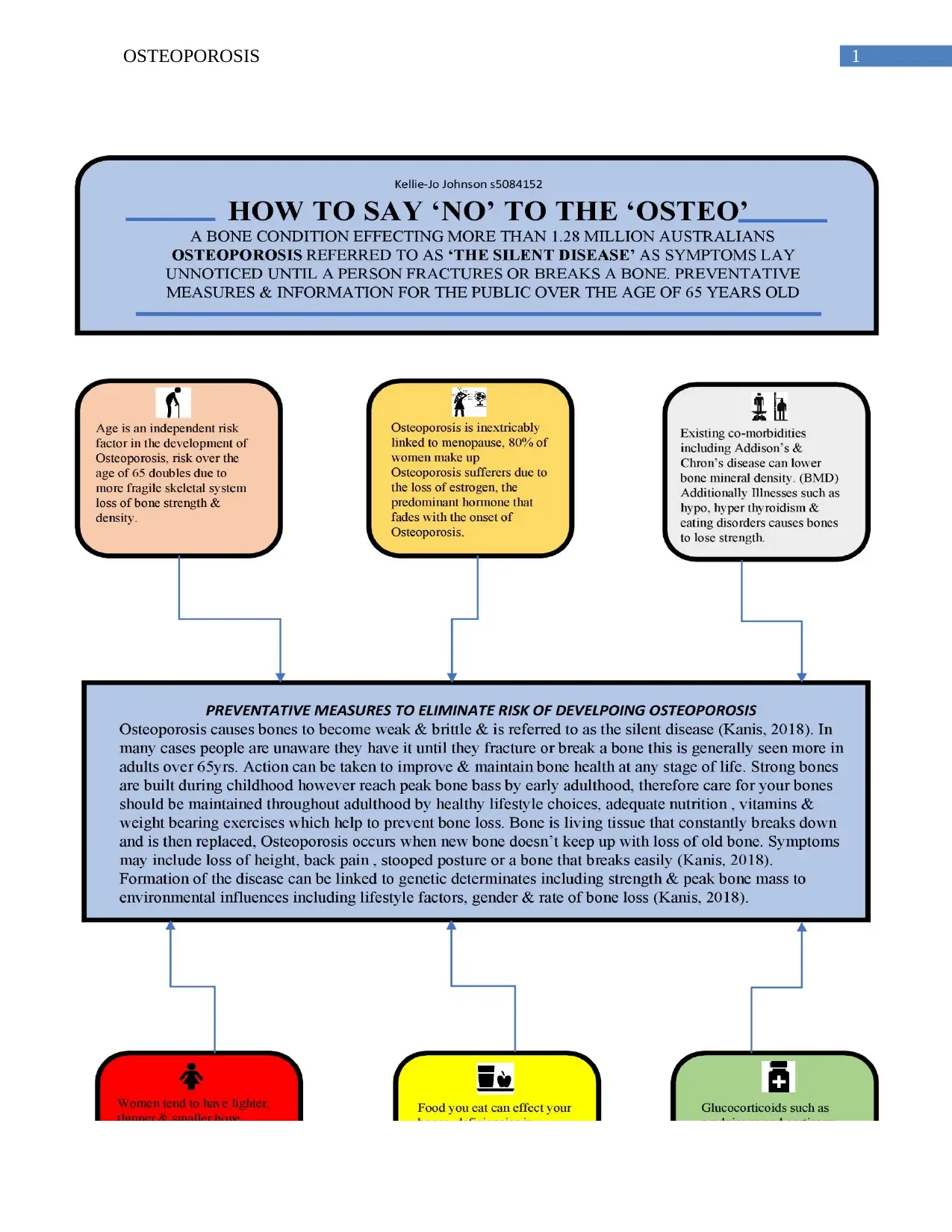
1OSTEOPOROSIS
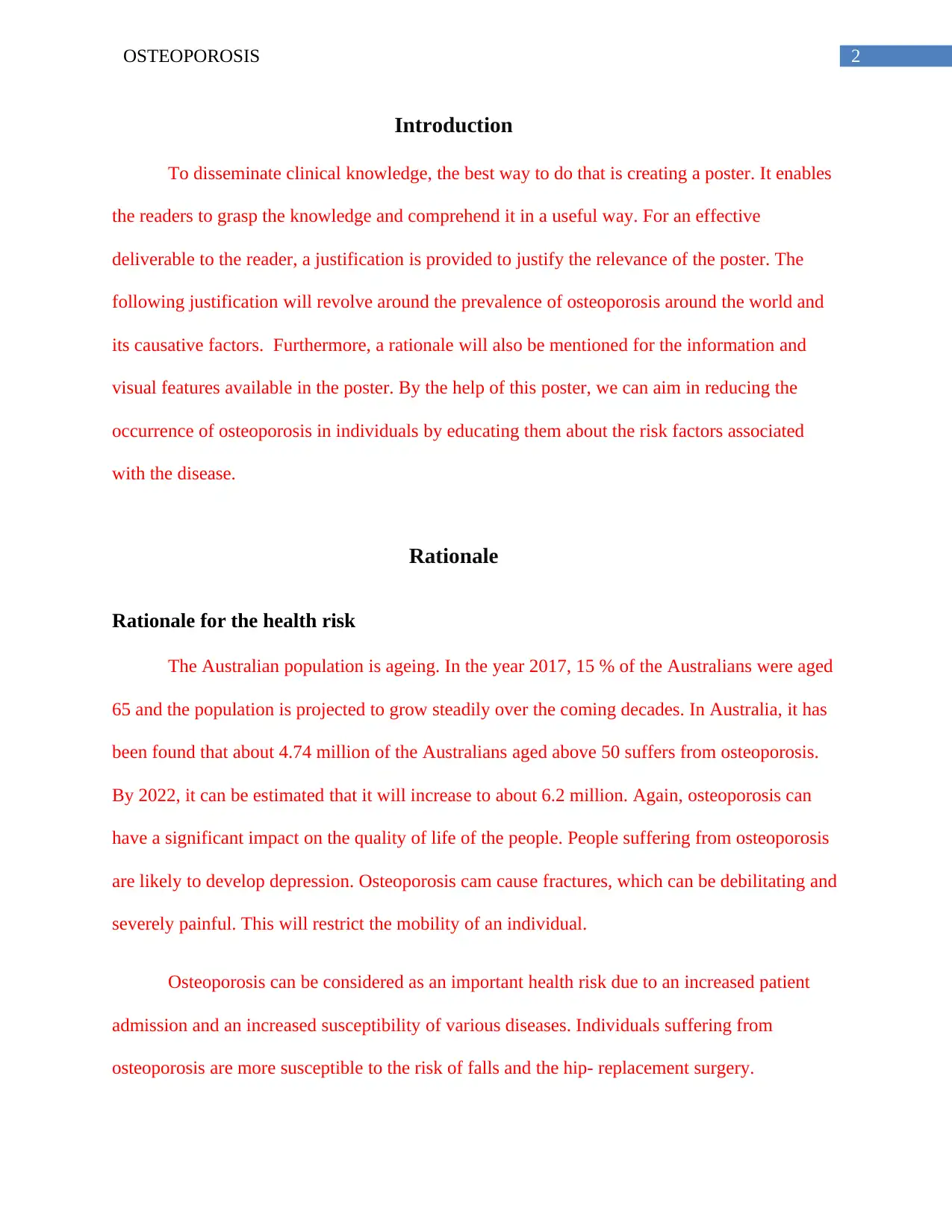
2OSTEOPOROSIS
Introduction
To disseminate clinical knowledge, the best way to do that is creating a poster. It enables
the readers to grasp the knowledge and comprehend it in a useful way. For an effective
deliverable to the reader, a justification is provided to justify the relevance of the poster. The
following justification will revolve around the prevalence of osteoporosis around the world and
its causative factors. Furthermore, a rationale will also be mentioned for the information and
visual features available in the poster. By the help of this poster, we can aim in reducing the
occurrence of osteoporosis in individuals by educating them about the risk factors associated
with the disease.
Rationale
Rationale for the health risk
The Australian population is ageing. In the year 2017, 15 % of the Australians were aged
65 and the population is projected to grow steadily over the coming decades. In Australia, it has
been found that about 4.74 million of the Australians aged above 50 suffers from osteoporosis.
By 2022, it can be estimated that it will increase to about 6.2 million. Again, osteoporosis can
have a significant impact on the quality of life of the people. People suffering from osteoporosis
are likely to develop depression. Osteoporosis cam cause fractures, which can be debilitating and
severely painful. This will restrict the mobility of an individual.
Osteoporosis can be considered as an important health risk due to an increased patient
admission and an increased susceptibility of various diseases. Individuals suffering from
osteoporosis are more susceptible to the risk of falls and the hip- replacement surgery.
Introduction
To disseminate clinical knowledge, the best way to do that is creating a poster. It enables
the readers to grasp the knowledge and comprehend it in a useful way. For an effective
deliverable to the reader, a justification is provided to justify the relevance of the poster. The
following justification will revolve around the prevalence of osteoporosis around the world and
its causative factors. Furthermore, a rationale will also be mentioned for the information and
visual features available in the poster. By the help of this poster, we can aim in reducing the
occurrence of osteoporosis in individuals by educating them about the risk factors associated
with the disease.
Rationale
Rationale for the health risk
The Australian population is ageing. In the year 2017, 15 % of the Australians were aged
65 and the population is projected to grow steadily over the coming decades. In Australia, it has
been found that about 4.74 million of the Australians aged above 50 suffers from osteoporosis.
By 2022, it can be estimated that it will increase to about 6.2 million. Again, osteoporosis can
have a significant impact on the quality of life of the people. People suffering from osteoporosis
are likely to develop depression. Osteoporosis cam cause fractures, which can be debilitating and
severely painful. This will restrict the mobility of an individual.
Osteoporosis can be considered as an important health risk due to an increased patient
admission and an increased susceptibility of various diseases. Individuals suffering from
osteoporosis are more susceptible to the risk of falls and the hip- replacement surgery.
⊘ This is a preview!⊘
Do you want full access?
Subscribe today to unlock all pages.

Trusted by 1+ million students worldwide
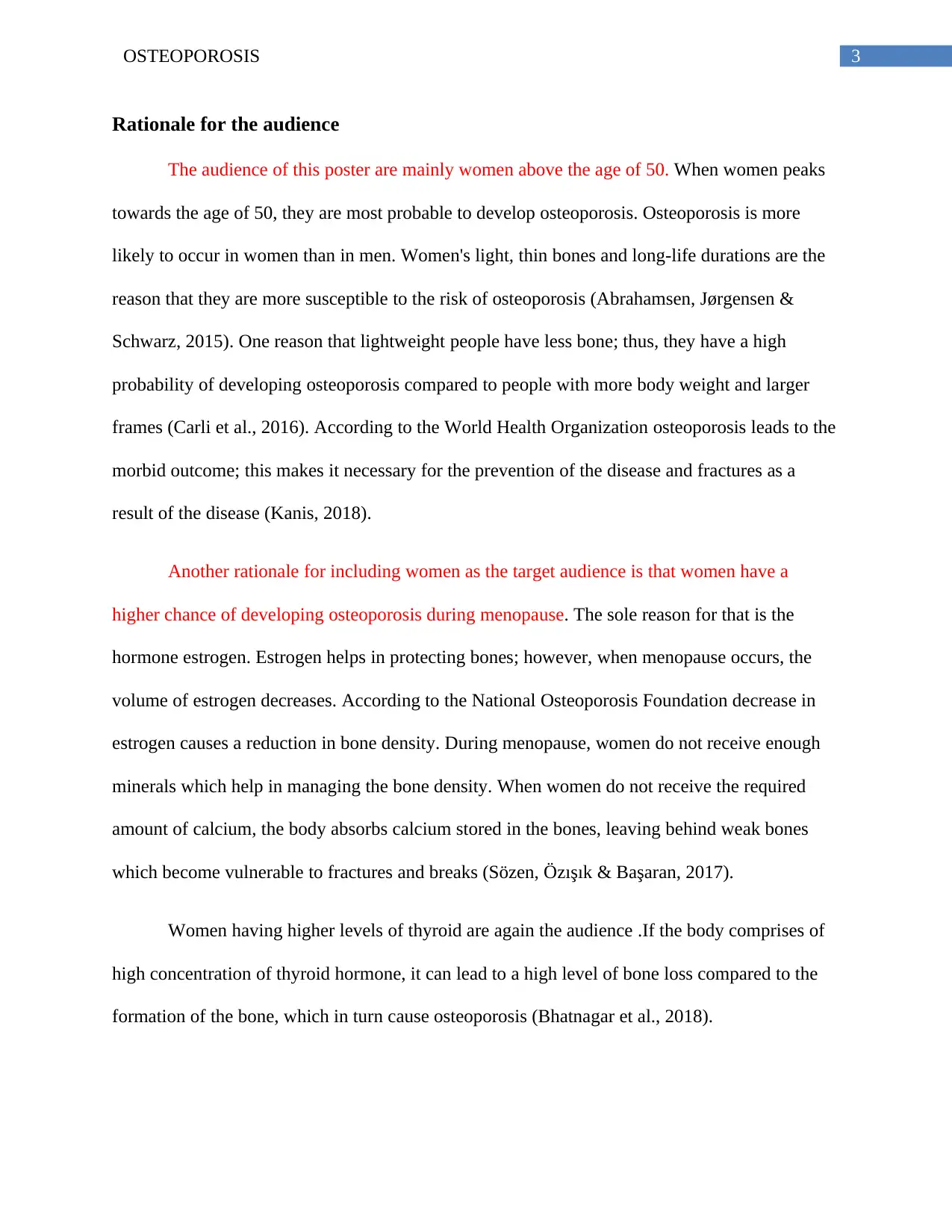
3OSTEOPOROSIS
Rationale for the audience
The audience of this poster are mainly women above the age of 50. When women peaks
towards the age of 50, they are most probable to develop osteoporosis. Osteoporosis is more
likely to occur in women than in men. Women's light, thin bones and long-life durations are the
reason that they are more susceptible to the risk of osteoporosis (Abrahamsen, Jørgensen &
Schwarz, 2015). One reason that lightweight people have less bone; thus, they have a high
probability of developing osteoporosis compared to people with more body weight and larger
frames (Carli et al., 2016). According to the World Health Organization osteoporosis leads to the
morbid outcome; this makes it necessary for the prevention of the disease and fractures as a
result of the disease (Kanis, 2018).
Another rationale for including women as the target audience is that women have a
higher chance of developing osteoporosis during menopause. The sole reason for that is the
hormone estrogen. Estrogen helps in protecting bones; however, when menopause occurs, the
volume of estrogen decreases. According to the National Osteoporosis Foundation decrease in
estrogen causes a reduction in bone density. During menopause, women do not receive enough
minerals which help in managing the bone density. When women do not receive the required
amount of calcium, the body absorbs calcium stored in the bones, leaving behind weak bones
which become vulnerable to fractures and breaks (Sözen, Özışık & Başaran, 2017).
Women having higher levels of thyroid are again the audience .If the body comprises of
high concentration of thyroid hormone, it can lead to a high level of bone loss compared to the
formation of the bone, which in turn cause osteoporosis (Bhatnagar et al., 2018).
Rationale for the audience
The audience of this poster are mainly women above the age of 50. When women peaks
towards the age of 50, they are most probable to develop osteoporosis. Osteoporosis is more
likely to occur in women than in men. Women's light, thin bones and long-life durations are the
reason that they are more susceptible to the risk of osteoporosis (Abrahamsen, Jørgensen &
Schwarz, 2015). One reason that lightweight people have less bone; thus, they have a high
probability of developing osteoporosis compared to people with more body weight and larger
frames (Carli et al., 2016). According to the World Health Organization osteoporosis leads to the
morbid outcome; this makes it necessary for the prevention of the disease and fractures as a
result of the disease (Kanis, 2018).
Another rationale for including women as the target audience is that women have a
higher chance of developing osteoporosis during menopause. The sole reason for that is the
hormone estrogen. Estrogen helps in protecting bones; however, when menopause occurs, the
volume of estrogen decreases. According to the National Osteoporosis Foundation decrease in
estrogen causes a reduction in bone density. During menopause, women do not receive enough
minerals which help in managing the bone density. When women do not receive the required
amount of calcium, the body absorbs calcium stored in the bones, leaving behind weak bones
which become vulnerable to fractures and breaks (Sözen, Özışık & Başaran, 2017).
Women having higher levels of thyroid are again the audience .If the body comprises of
high concentration of thyroid hormone, it can lead to a high level of bone loss compared to the
formation of the bone, which in turn cause osteoporosis (Bhatnagar et al., 2018).
Paraphrase This Document
Need a fresh take? Get an instant paraphrase of this document with our AI Paraphraser
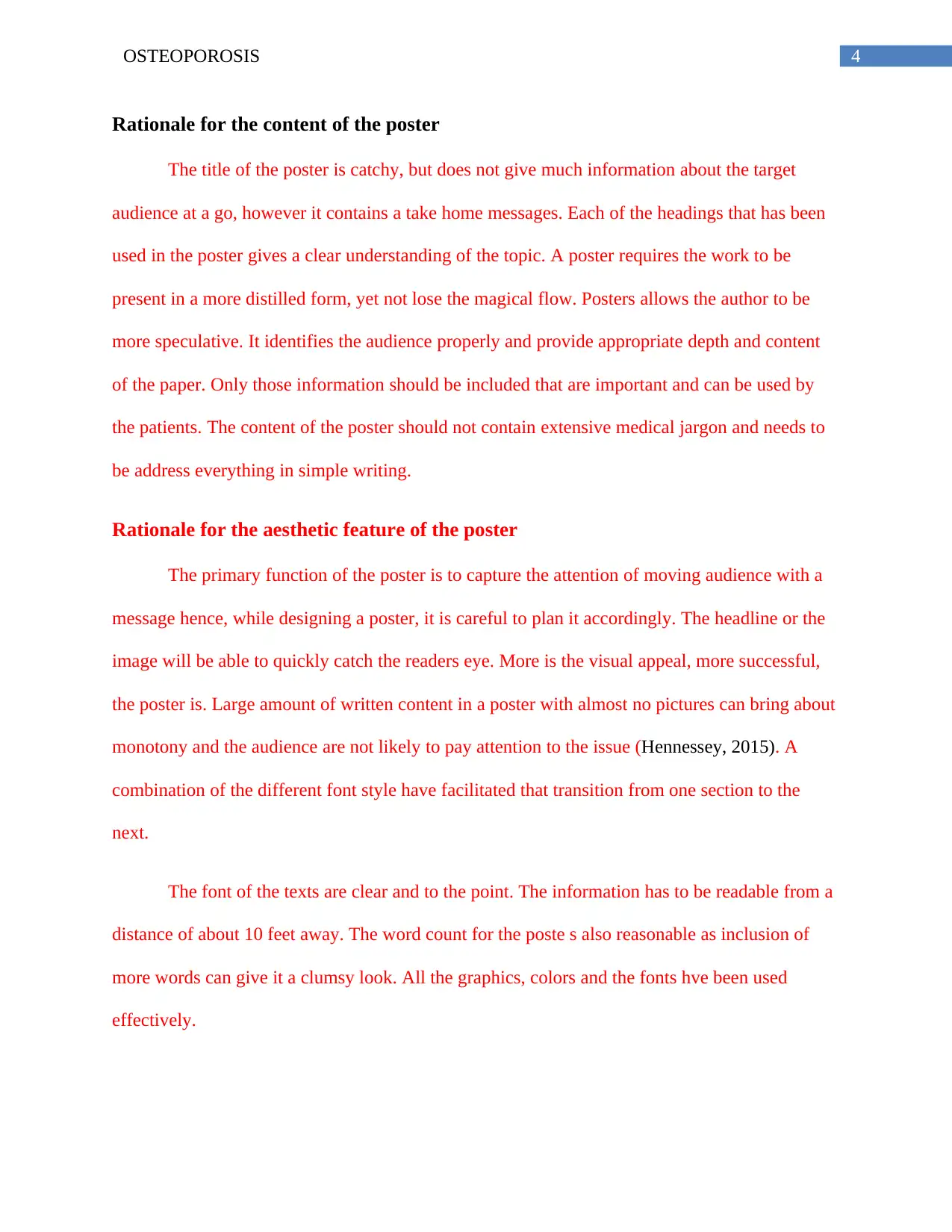
4OSTEOPOROSIS
Rationale for the content of the poster
The title of the poster is catchy, but does not give much information about the target
audience at a go, however it contains a take home messages. Each of the headings that has been
used in the poster gives a clear understanding of the topic. A poster requires the work to be
present in a more distilled form, yet not lose the magical flow. Posters allows the author to be
more speculative. It identifies the audience properly and provide appropriate depth and content
of the paper. Only those information should be included that are important and can be used by
the patients. The content of the poster should not contain extensive medical jargon and needs to
be address everything in simple writing.
Rationale for the aesthetic feature of the poster
The primary function of the poster is to capture the attention of moving audience with a
message hence, while designing a poster, it is careful to plan it accordingly. The headline or the
image will be able to quickly catch the readers eye. More is the visual appeal, more successful,
the poster is. Large amount of written content in a poster with almost no pictures can bring about
monotony and the audience are not likely to pay attention to the issue (Hennessey, 2015). A
combination of the different font style have facilitated that transition from one section to the
next.
The font of the texts are clear and to the point. The information has to be readable from a
distance of about 10 feet away. The word count for the poste s also reasonable as inclusion of
more words can give it a clumsy look. All the graphics, colors and the fonts hve been used
effectively.
Rationale for the content of the poster
The title of the poster is catchy, but does not give much information about the target
audience at a go, however it contains a take home messages. Each of the headings that has been
used in the poster gives a clear understanding of the topic. A poster requires the work to be
present in a more distilled form, yet not lose the magical flow. Posters allows the author to be
more speculative. It identifies the audience properly and provide appropriate depth and content
of the paper. Only those information should be included that are important and can be used by
the patients. The content of the poster should not contain extensive medical jargon and needs to
be address everything in simple writing.
Rationale for the aesthetic feature of the poster
The primary function of the poster is to capture the attention of moving audience with a
message hence, while designing a poster, it is careful to plan it accordingly. The headline or the
image will be able to quickly catch the readers eye. More is the visual appeal, more successful,
the poster is. Large amount of written content in a poster with almost no pictures can bring about
monotony and the audience are not likely to pay attention to the issue (Hennessey, 2015). A
combination of the different font style have facilitated that transition from one section to the
next.
The font of the texts are clear and to the point. The information has to be readable from a
distance of about 10 feet away. The word count for the poste s also reasonable as inclusion of
more words can give it a clumsy look. All the graphics, colors and the fonts hve been used
effectively.
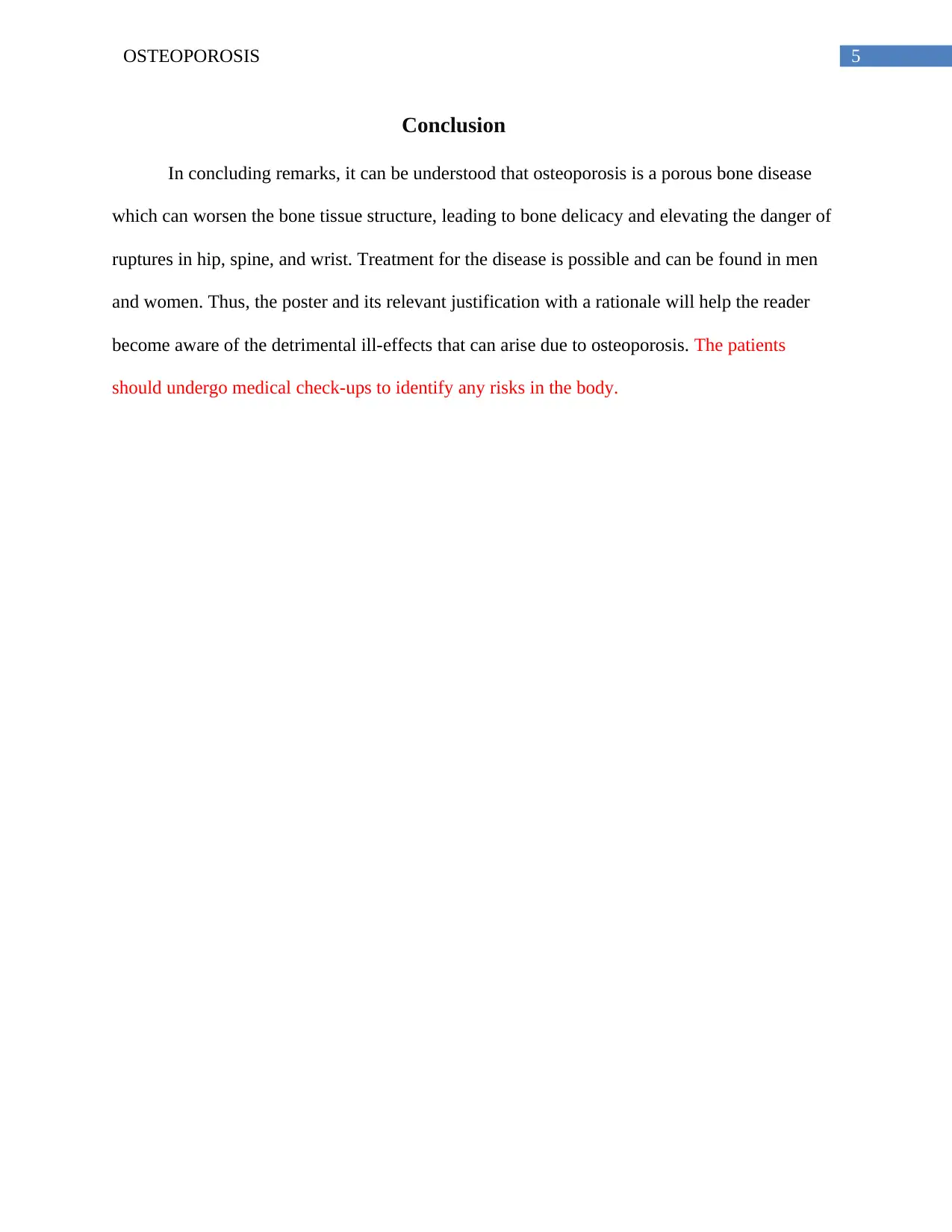
5OSTEOPOROSIS
Conclusion
In concluding remarks, it can be understood that osteoporosis is a porous bone disease
which can worsen the bone tissue structure, leading to bone delicacy and elevating the danger of
ruptures in hip, spine, and wrist. Treatment for the disease is possible and can be found in men
and women. Thus, the poster and its relevant justification with a rationale will help the reader
become aware of the detrimental ill-effects that can arise due to osteoporosis. The patients
should undergo medical check-ups to identify any risks in the body.
Conclusion
In concluding remarks, it can be understood that osteoporosis is a porous bone disease
which can worsen the bone tissue structure, leading to bone delicacy and elevating the danger of
ruptures in hip, spine, and wrist. Treatment for the disease is possible and can be found in men
and women. Thus, the poster and its relevant justification with a rationale will help the reader
become aware of the detrimental ill-effects that can arise due to osteoporosis. The patients
should undergo medical check-ups to identify any risks in the body.
⊘ This is a preview!⊘
Do you want full access?
Subscribe today to unlock all pages.

Trusted by 1+ million students worldwide
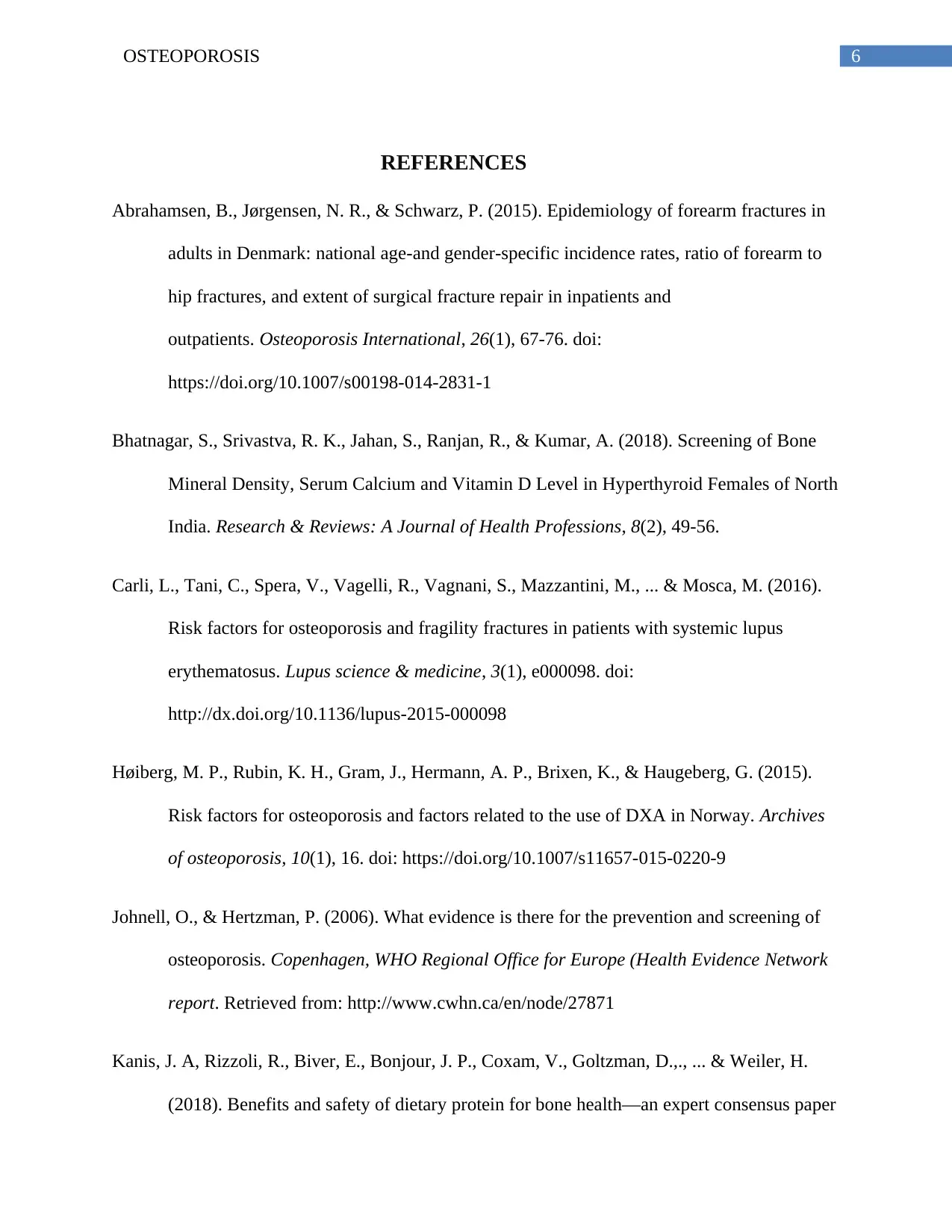
6OSTEOPOROSIS
REFERENCES
Abrahamsen, B., Jørgensen, N. R., & Schwarz, P. (2015). Epidemiology of forearm fractures in
adults in Denmark: national age-and gender-specific incidence rates, ratio of forearm to
hip fractures, and extent of surgical fracture repair in inpatients and
outpatients. Osteoporosis International, 26(1), 67-76. doi:
https://doi.org/10.1007/s00198-014-2831-1
Bhatnagar, S., Srivastva, R. K., Jahan, S., Ranjan, R., & Kumar, A. (2018). Screening of Bone
Mineral Density, Serum Calcium and Vitamin D Level in Hyperthyroid Females of North
India. Research & Reviews: A Journal of Health Professions, 8(2), 49-56.
Carli, L., Tani, C., Spera, V., Vagelli, R., Vagnani, S., Mazzantini, M., ... & Mosca, M. (2016).
Risk factors for osteoporosis and fragility fractures in patients with systemic lupus
erythematosus. Lupus science & medicine, 3(1), e000098. doi:
http://dx.doi.org/10.1136/lupus-2015-000098
Høiberg, M. P., Rubin, K. H., Gram, J., Hermann, A. P., Brixen, K., & Haugeberg, G. (2015).
Risk factors for osteoporosis and factors related to the use of DXA in Norway. Archives
of osteoporosis, 10(1), 16. doi: https://doi.org/10.1007/s11657-015-0220-9
Johnell, O., & Hertzman, P. (2006). What evidence is there for the prevention and screening of
osteoporosis. Copenhagen, WHO Regional Office for Europe (Health Evidence Network
report. Retrieved from: http://www.cwhn.ca/en/node/27871
Kanis, J. A, Rizzoli, R., Biver, E., Bonjour, J. P., Coxam, V., Goltzman, D.,., ... & Weiler, H.
(2018). Benefits and safety of dietary protein for bone health—an expert consensus paper
REFERENCES
Abrahamsen, B., Jørgensen, N. R., & Schwarz, P. (2015). Epidemiology of forearm fractures in
adults in Denmark: national age-and gender-specific incidence rates, ratio of forearm to
hip fractures, and extent of surgical fracture repair in inpatients and
outpatients. Osteoporosis International, 26(1), 67-76. doi:
https://doi.org/10.1007/s00198-014-2831-1
Bhatnagar, S., Srivastva, R. K., Jahan, S., Ranjan, R., & Kumar, A. (2018). Screening of Bone
Mineral Density, Serum Calcium and Vitamin D Level in Hyperthyroid Females of North
India. Research & Reviews: A Journal of Health Professions, 8(2), 49-56.
Carli, L., Tani, C., Spera, V., Vagelli, R., Vagnani, S., Mazzantini, M., ... & Mosca, M. (2016).
Risk factors for osteoporosis and fragility fractures in patients with systemic lupus
erythematosus. Lupus science & medicine, 3(1), e000098. doi:
http://dx.doi.org/10.1136/lupus-2015-000098
Høiberg, M. P., Rubin, K. H., Gram, J., Hermann, A. P., Brixen, K., & Haugeberg, G. (2015).
Risk factors for osteoporosis and factors related to the use of DXA in Norway. Archives
of osteoporosis, 10(1), 16. doi: https://doi.org/10.1007/s11657-015-0220-9
Johnell, O., & Hertzman, P. (2006). What evidence is there for the prevention and screening of
osteoporosis. Copenhagen, WHO Regional Office for Europe (Health Evidence Network
report. Retrieved from: http://www.cwhn.ca/en/node/27871
Kanis, J. A, Rizzoli, R., Biver, E., Bonjour, J. P., Coxam, V., Goltzman, D.,., ... & Weiler, H.
(2018). Benefits and safety of dietary protein for bone health—an expert consensus paper
Paraphrase This Document
Need a fresh take? Get an instant paraphrase of this document with our AI Paraphraser
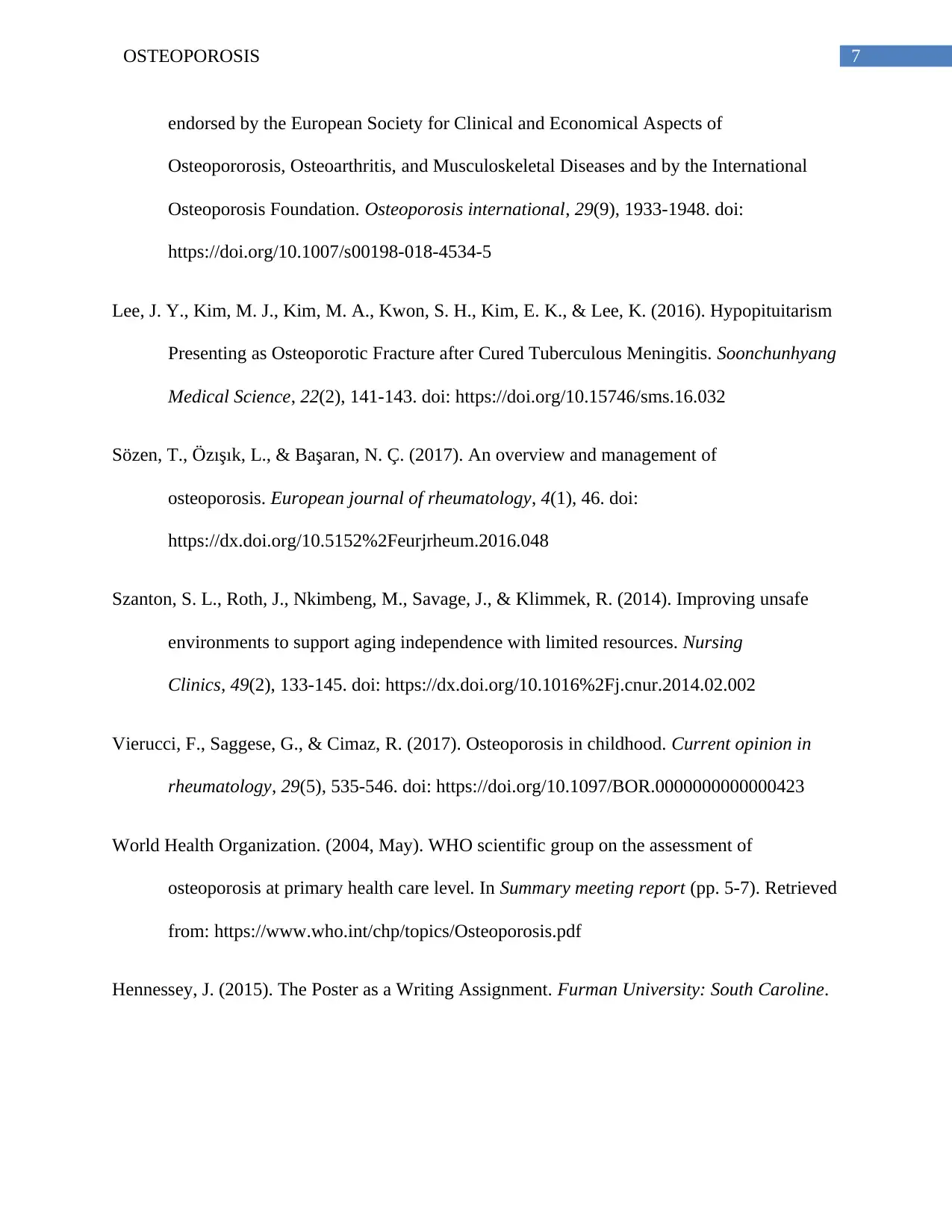
7OSTEOPOROSIS
endorsed by the European Society for Clinical and Economical Aspects of
Osteopororosis, Osteoarthritis, and Musculoskeletal Diseases and by the International
Osteoporosis Foundation. Osteoporosis international, 29(9), 1933-1948. doi:
https://doi.org/10.1007/s00198-018-4534-5
Lee, J. Y., Kim, M. J., Kim, M. A., Kwon, S. H., Kim, E. K., & Lee, K. (2016). Hypopituitarism
Presenting as Osteoporotic Fracture after Cured Tuberculous Meningitis. Soonchunhyang
Medical Science, 22(2), 141-143. doi: https://doi.org/10.15746/sms.16.032
Sözen, T., Özışık, L., & Başaran, N. Ç. (2017). An overview and management of
osteoporosis. European journal of rheumatology, 4(1), 46. doi:
https://dx.doi.org/10.5152%2Feurjrheum.2016.048
Szanton, S. L., Roth, J., Nkimbeng, M., Savage, J., & Klimmek, R. (2014). Improving unsafe
environments to support aging independence with limited resources. Nursing
Clinics, 49(2), 133-145. doi: https://dx.doi.org/10.1016%2Fj.cnur.2014.02.002
Vierucci, F., Saggese, G., & Cimaz, R. (2017). Osteoporosis in childhood. Current opinion in
rheumatology, 29(5), 535-546. doi: https://doi.org/10.1097/BOR.0000000000000423
World Health Organization. (2004, May). WHO scientific group on the assessment of
osteoporosis at primary health care level. In Summary meeting report (pp. 5-7). Retrieved
from: https://www.who.int/chp/topics/Osteoporosis.pdf
Hennessey, J. (2015). The Poster as a Writing Assignment. Furman University: South Caroline.
endorsed by the European Society for Clinical and Economical Aspects of
Osteopororosis, Osteoarthritis, and Musculoskeletal Diseases and by the International
Osteoporosis Foundation. Osteoporosis international, 29(9), 1933-1948. doi:
https://doi.org/10.1007/s00198-018-4534-5
Lee, J. Y., Kim, M. J., Kim, M. A., Kwon, S. H., Kim, E. K., & Lee, K. (2016). Hypopituitarism
Presenting as Osteoporotic Fracture after Cured Tuberculous Meningitis. Soonchunhyang
Medical Science, 22(2), 141-143. doi: https://doi.org/10.15746/sms.16.032
Sözen, T., Özışık, L., & Başaran, N. Ç. (2017). An overview and management of
osteoporosis. European journal of rheumatology, 4(1), 46. doi:
https://dx.doi.org/10.5152%2Feurjrheum.2016.048
Szanton, S. L., Roth, J., Nkimbeng, M., Savage, J., & Klimmek, R. (2014). Improving unsafe
environments to support aging independence with limited resources. Nursing
Clinics, 49(2), 133-145. doi: https://dx.doi.org/10.1016%2Fj.cnur.2014.02.002
Vierucci, F., Saggese, G., & Cimaz, R. (2017). Osteoporosis in childhood. Current opinion in
rheumatology, 29(5), 535-546. doi: https://doi.org/10.1097/BOR.0000000000000423
World Health Organization. (2004, May). WHO scientific group on the assessment of
osteoporosis at primary health care level. In Summary meeting report (pp. 5-7). Retrieved
from: https://www.who.int/chp/topics/Osteoporosis.pdf
Hennessey, J. (2015). The Poster as a Writing Assignment. Furman University: South Caroline.

8OSTEOPOROSIS
⊘ This is a preview!⊘
Do you want full access?
Subscribe today to unlock all pages.

Trusted by 1+ million students worldwide
1 out of 9
Related Documents
Your All-in-One AI-Powered Toolkit for Academic Success.
+13062052269
info@desklib.com
Available 24*7 on WhatsApp / Email
![[object Object]](/_next/static/media/star-bottom.7253800d.svg)
Unlock your academic potential
Copyright © 2020–2025 A2Z Services. All Rights Reserved. Developed and managed by ZUCOL.





